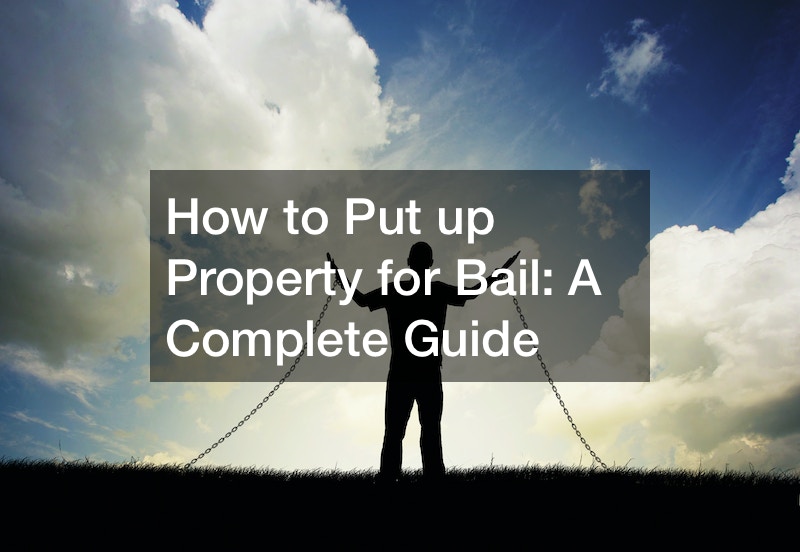
When someone gets arrested, it’s only natural for them to want their freedom back. The court system allows people to post bail, releasing them from jail while their case is handled. This process requires some form of acceptable collateral, such as property, which can be used as security to ensure the accused person shows up in court on the day they’re supposed to. If you’re a property owner, you may be interested in the finer details of how to put up property for bail. This article provides you with the answers you need. It covers all the essential topics, such as how bail works, the responsibilities of a bail bondsman, and the process of how to put up property for bail.
How Does Bail Work?

Before you can understand how to put up property for bail, it’s essential to understand how bail works. Simply put, bail usually refers to money that must be paid after someone has been charged with a crime. This money has to be paid before the arrested person can be freed from jail. However, note that paying bail doesn’t mean the accused is free forever. It only means they are free to go back home but will be required to attend court at a later date to defend their case. No specific amount can be charged for bail because each case is unique. Bail may not even be required in cases where the infraction is minor. The main factor that is considered when setting bail is whether the required amount will create financial hardships for the loved ones that have to pay.
If a person is charged with a crime eligible for bail, the judge will only grant bail if they determine the person is not a flight risk. This means if you’re released to go home, you can be trusted to return and attend your trial when you’re supposed to. But if the judge determines that you’re more likely to flee from prosecution, they may not grant bail. Either that or you may be placed under house arrest or required to wear an electronic monitoring device. Alternatively, you may be required to report to the authorities at scheduled times.
The principle behind bail is that someone will be more motivated to show up in court if they have something to lose. Let’s say you have been arrested, and a family or friend posts bail for you. If you’re a trustworthy person, you have to hold up your end of the deal. Otherwise, the person who has posted bail may lose a large amount of cash because of you. The principle of bail and the justice system applies to everyone, whether civilians, military personnel lawyers, judges, Catholic charities, or anyone else. Overall, this is a system that’s designed to boost court attendance among people who are awaiting trial while at home. That said, the system is heavily skewed towards the ‘rich.’ If you have money or assets, you can easily buy your freedom. Otherwise, you’re stuck in jail until your sentencing.
What Are the Different Types of Bail?

The good news is that bail doesn’t only have to be in the form of money. This explains why this article is also considering the question of how to put up property for bail. When you’re considering how to put up property for bail, you’re looking at what is known as a property bond. But before we consider this type of bond, let’s consider the other types of bonds to give you a bigger picture. As mentioned, bail is typically posted in the form of cash, which is usually paid to the court clerk at the jail or facility the arrested person is being held. It can also be paid online.
A cash bond is a simple payment you can either make directly to the courts or pay using a check or credit card, depending on what’s accepted. A federal bail bond is required if the person has been charged with a federal crime, such as a bank robbery, and it’s usually a significant amount. Another type of bail is the surety bond, provided by a third party. This is usually a professional bail bonds corporation with licensed bail bondsmen that promises to pay the required amount if the accused person doesn’t attend court when they’re supposed to.
Then there’s a property bond, which is the main focus here for those interested in how to put up property for bail. With a property bond, your home can be used in lieu of cash since it’s considered a suitable asset. That means the courts can seize your home should the accused fail to appear in court. You should note there are some types of bonds where the person can be released without paying any money. For instance, a person can be released on their own personal recognizance, and they are not required to pay any money if they don’t pose a danger to the community. Other forms of bonds include insurance company bonds or partially secured bonds.
Everything You Need to Know About Bail Bonds
Whether you have been arrested or your loved one has been arrested, this period can be quite stressful. Despite the court’s best intentions, you or your family might face undue hardship while trying to meet the bail requirements imposed by the judge. The unfortunate thing is that the required bail amount can be substantial, so you can’t walk into a pawn shop and free up that kind of money. This is where bail bonds come in. Bail bonds allow the defendant to get out of jail until their court date. It’s a type of surety bond provided by a bail bond agency on behalf of the defendant.
The obvious advantage of a bail bond is that your or your loved one won’t have to use their money to post bail. That said, before the bail bond agency can pledge money as a surety that the defendant will show up in court on the scheduled date, you have to pay them a fee. This fee is necessary because there’s always the risk the accused won’t show up in court, at which point money is lost. According to Investopedia, bail bonds generally charge up to 10% of the bail money. So, if your bail is set at $20,000, then the bail bond agent will charge you $2,000 to get out.
This fee is required upfront and may be accompanied by additional fees. The fee might be lower than 10% if you’re lucky enough to live in a state where bail bonds are regulated. Remember that using the services means that any fees are non-refundable. So, you’ll not get back your money. But if you personally posted a cash bond, you’ll get back your money. Bail bonds are not available in all states in the U.S. According to Cornell Law School, Illinois, Kentucky, Oregon, and Wisconsin are four states that have banned commercial bail bonds.
What Does a Bail Bondsman Do?

As stated, the bail bonds industry caters to those who don’t have the financial resources to post their own bail. Without engaging the services of a bail bonds company, the accused person must remain in jail until their next scheduled court date. If you decide to use the services of a bail bonds company, it doesn’t matter whether you’re found guilty or not guilty, or if the charges are dropped, you’ll not get your money back. That is the price a bail bond agent demands for taking on the risk associated with posting your bail. Some bail bonds companies are even so accommodating as to provide you with a payment plan. This makes bail even more affordable to those with financial limitations as they can pay in installments.
Let’s say you’re interested in knowing more about what a bail bondsman does. You may be wondering, ‘How exactly does the process work?’ If you or your loved one has been arrested, you should be able to contact a bail bondsman as soon as the bail has been set. You’ll need to provide the bail bond agent with the information they need, such as the name of the person arrested, the name of the correctional facility where they’re being held, their booking number, and the charges they’re facing. The agent will need you to pay the required amount and complete some paperwork before they can provide the surety bond. Once they post the bail, release from jail follows, usually within a few hours.
When the defendant has been released from jail, it’s crucial that they meet the conditions of the bail by appearing at their next scheduled court date. However, it’s not uncommon to hear many cases of people that skip bail. If your loved one has been arrested and then released on bail, it’s important that you check in with them regularly and provide them with the support they need. This helps lower their flight risk, but if they skip bail, the bail bond agent will require information from you so they can be found. The bail bond agent is on the hook because if the accused fails to show up as planned, the agent will be responsible for paying the full amount. It’s up to the agent to find the defendant and bring them so they can recover their money within a specified period. This explains why bail bond companies employ bounty hunters to find and bring back the defendant to court within the grace period.
How Do You Use Your Home for Bail?

Now that we have provided comprehensive background information, it’s time to answer the question of how to put up property for bail in more detail. When you approach a bail bond company to bail someone out of jail, and you want to provide collateral in the form of your home, the company will record a Deed of Trust against your home. This Deed of Trust is simply formal paperwork used as evidence that your property is acting as security for the bail amount. If you check the document, the homeowner will be named the trustor, while the bail bond company is referred to as the beneficiary.
If the defendant appears in court according to the contract, the court will return the bail that the bail company has posted. If the person skips bail and can’t be found, then the bail bond company loses the money they posted for bail. So, if the bail bond company paid $50,000, they won’t get this money back. The company will demand that you pay back the money. Otherwise, they will foreclose on the property to recover their lost money. If the home is foreclosed, you may look for moving companies, towing companies, and storage units to facilitate moving out of the home. So, if you want to know how to put up property for bail, remember there’s always the risk you might lose your house. Also, note that you can approach the courts directly if you want to bail someone out with a bail bond.
So, in essence, posting a property bond is quite simple. First, there’s an evaluation to determine the home’s owners, the home’s value, and the equity built up. You also need to submit documents, such as a property liens history, the deed, and mortgage statements. An up-to-date appraisal of your home is also required, which considers the current condition of your home based on the state of your plumbing, water heater, HVAC, and other systems. Once the home’s true value has been deemed sufficient to ensure the bond, the necessary paperwork will be drawn, you sign it, and it’s done.
This is the basic information you need to know when it comes to how to put up property for bail. If you were not sure how to put up property for bail before, now you should have all the details you need to proceed confidently with the process of using your property as collateral. Be sure to consider all the information provided in this article to understand the risk. Also, remember that you may have no control over other aspects of the situation. That’s because the outcome is also heavily influenced by the laws of the state in which you live, the amount of equity you hold in the property, as well as the judge’s decision who will be presiding over the case.



